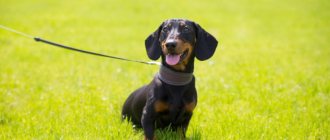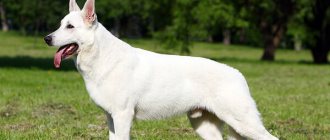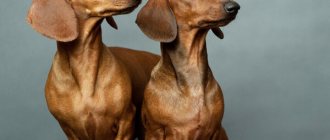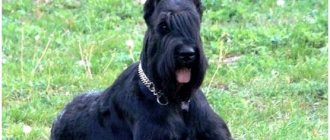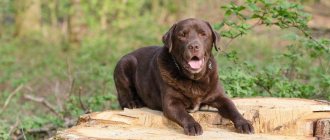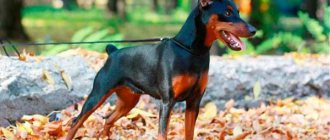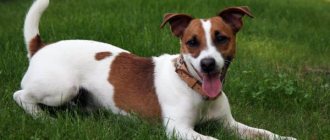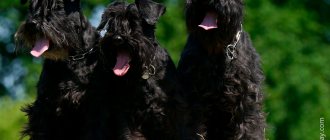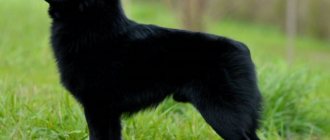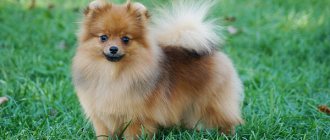Spitz is not just a breed of dog, it is a whole group of animals, according to the classification of the International Canine Organization. Inside there are separate sections for large and decorative pets, hunters, sled dogs or herding dogs. In our understanding, the Spitz is a small decorative fluffy dog, but in fact, almost all known Laikas also belong to this group.
The article collects breeds based on similar external characteristics: pointed ears, square body, long hair, wedge-shaped head with a fox-like muzzle and straight, thin limbs. The Spitz's tail is thrown over its back or hangs calmly. Interestingly, all dogs from the group have one common ancestor - the northern wolf.
American Eskimo dog
The breed appeared from a branch of the German Spitz, brought to America at the end of the 19th century. Due to anti-German sentiments, the dogs were renamed American, but after 10 years the animals became different from their brothers.
There is an opinion that Samoyed huskies were involved in selection and breeding. The US Kennel Club recognized the new breed and called it Eskimo, but the world organization has not yet added it to the Spitz group.
These are white dogs with long fluffy hair and a dense undercoat. They have a typical Spitz body type, a standard head, but the ears are large and feathered. The dogs are medium-sized, have 3 height variations:
- Toy (22-30 cm at the withers);
- Mini (30-38 cm);
- Standard (up to 48 cm).
The breed is new, so individuals with unusual behavior or deviations are rarely encountered. American Eskimos are not picky: depending on their size, they can live in an apartment or in a country house with an aviary. They are used for police service (you can train a bloodhound or guard dog), sports or exhibitions.
They are affectionate and kind with their owners, treat children well, and do not snap or get angry. But with strangers they are reserved and wary. Animals are always active, playful, and life-loving, but they can become offended, lazy, or manipulate their owners. The average cost for puppies of this breed is 15-30 thousand rubles.
Asian types of Spitz and related breeds
The Asian Spitz section included 12 breeds. Some of them developed separately, although the characteristic features of a Spitz can be traced in their appearance - straight double coat, wedge-shaped head, curled tail. European Spitz dogs participated in the selection of individual Asian Spitz-type dogs.
Akita Inu
The largest of the 6 native Japanese dogs. There were periods in history when they hunted bears and took part in dog fights. Now the Akita Inu has only one purpose - as a companion dog.
Akita came to world fame after the release of the film Hachiko.
The height of the Japanese Akita is 61 – 67 cm. Basic colors:
- red-fawn;
- white;
- brindle;
- sesame - a mixture of red, black, white hair.
The main color is complemented by urajiro - light symmetrical markings on the neck, cheeks, belly, chest, inner surface of the legs, and the bottom of the tail.
Akita Inu puppy.
The standard describes the Akita Inu as a reserved, loyal, receptive and obedient dog.
Kai
An ancient breed that formed on the Japanese island of Honshu in the Kai province. The animals were bred for hunting in a separate area surrounded by a chain of mountains, so the pristine nature of the breed was preserved.
The height of Kai Inu is 48 – 53 cm.
Puppies are born with a uniform coat. Contrasting tiger stripes gradually appear. Because of its color, the kai received a second name - brindle dog.
Kai puppy.
Kais are kept as hunters and companions. Their independent nature prevents them from being obedient pets. Proud dogs recognize and obey only one owner. The rest are treated aloofly, but without aggression. They are rare outside their homeland, although they are gaining popularity in Canada and the USA.
Kishu
An indigenous Japanese breed that began to form 3 thousand years ago in the Kishu province.
The height of kishu is 46 – 52 cm. The color is white, less often red and sesame.
Kisya is bred for hunting wild boar and bear. They are kept as guard dogs and companions. The standard describes the Kishu Inu as a hardy, noble, simple-minded, loyal and obedient dog.
Shiba Inu
The smallest of the indigenous Japanese breeds, Shiba Inu means small dog. Height does not exceed 40 cm. Standard colors: red, black with light tan and sesame.
Shiba Inu with a puppy.
Initially, compact shibas were bred for hunting birds in bushes. Nowadays they are often kept as companions. According to the owners, they have a friendly but difficult character. Shibas are capricious, so raising a pet requires a firm hand.
The one on the right is not a puppy. This is a mini Shiba and a standard one.
Since 1950, breeders began breeding mini Shiba Inu under 34 cm in height - mameshiba. However, cynological organizations do not approve of the “reduction” of the breed, considering it a violation of health and temperament.
Shikoku
Another indigenous Japanese breed, bred on the island of the same name. Height at withers 46 – 52 cm. Basic colors: sesame with an equal number of black, bleached and red hair, black-sesame, red sesame.
For Russia, Shikoku is a rare breed. Nurseries operate in Saratov and Vladivostok. This is what the RKF standard says about the Shikoku temperament.
Hardy, sensitive dog. The character is open and direct, the behavior is very wary. She is obedient to her owner. Gambling hunter.
Hokkaido or Ainu
The ancestors of Hokkaido came to the Japanese island of the same name along with the first people - the Ainu. Dogs served as universal assistants: guards, shepherds, hunters, fishermen.
Hokkaido height 48 – 51 cm. Colors:
- ginger;
- white;
- black solid or with tan;
- fawn with dark tips;
- brindle.
According to the standard, Hokkaido are brave, hardy, intelligent, with a lively temperament and a simple-minded character. They have an innate sense of direction: Ainu are able to return to their owner, being hundreds of kilometers from home.
Since 1928, 6 indigenous breeds of Japan have been protected by the Nippo Association, a club for the protection of indigenous Japanese dogs. And in the 30s, the Japanese government declared them a natural monument and national treasure.
American Akita
The breed began to take shape after the Second World War, when the American military brought Japanese Akita puppies home. During selection, they were crossed with German shepherds and English mastiffs.
American Akitas are larger than Japanese ones.
These are large, furry dogs, 61–71 cm tall. They have wider bones, a more voluminous muzzle, and almost any color is allowed by the standard.
According to owners' reviews, the American Akita is docile, receptive, and silent. Easy to train, does not show aggression towards the owner, family, or strangers. However, in an extreme situation he will be able to protect his family.
Korean Jindo or Jindo
Nothing is known about the origin of the Jindo, but there is no doubt about the fact that dogs have lived for centuries on the South Korean island of Jindo.
Jindo's height is up to 55 cm.
Jindo is a one-owner dog; he even accepts food only from the owner’s hands. In Korea, the story of a Jindo named Baekku is popular. The 83-year-old owner sold the pet to a new owner, who took the animal to another city 300 km away. After 7 months, tired and exhausted, Pekku returned to her previous owner.
Thai bangkaew
The breed first appeared in the Bangkaew settlement in north-central Thailand. The roots can be traced back to the first generation: the white and black bitch of a local clergyman and a wild jackal-shaped dog. The FCI recognized “Thais” only in 2011 and included Asian Spitz dogs in the section.
The coat is semi-long with decorative hair on the chest and tail. The color is white with black or colored spots. The standard describes the Bangkaew as an agile, intelligent, obedient dog that is easy to train.
Chow chow
Hairy chows appeared in China more than 2 thousand years ago, but spread throughout the world in the 1920s. They are compact, robust dogs related to the Scandinavian Spitz and Mastiff.
Chow seems large, in fact his height is 46 – 56 cm.
The breed has 2 types of coat: semi-long with rich feathering on the neck and hips and short plush, not adjacent to the body. The colors are monochromatic - red, white, cream, black, blue and cinnamon - from “café au lait” to cinnamon color. The breed's characteristic feature is a blue-black tongue.
A new fashion trend has spread in China. Chow chows are cut and dyed to resemble a bamboo panda bear. The procedure lasts 2 hours, and the “hairstyle” lasts 6 weeks.
Chow panda is not a species or color, but the result of a groomer’s work.
Chows are calm companions, vigilant watchmen. They behave with self-esteem, sometimes somewhat arrogantly.
Eurasier
The Eurasian Spitz was bred by German breeders J. Wipfel and S. Baldamus. Dog handlers decided to get a visually attractive dog of the northern type with an impeccable character, suitable for home keeping. To do this, they crossed a Chow Chow and a Wolfspitz, and later added Samoyed blood.
The height of the Eurasier is 48 – 60 cm. Colors are any solid except white and liver, zoned gray.
Eurasiers are companion dogs adapted for living in cities and rural areas. Thanks to their stable psyche, they behave in a balanced, confident manner, without unnecessary noise. The Eurasian Spitz does not have a developed hunting instinct; the main thing for him is his owner and family.
Japanese Spitz
The breed was created by Japanese cynologists in the 1920s and 30s based on imported white European and American Spitz dogs.
The Japanese Spitz is a snow-white dog 30 – 38 cm tall.
Japanese dog handlers sought to develop an exemplary home companion for families with children and the elderly. The result of painstaking breeding work was obedient, intelligent, sensitive pets. They are easy to train, patiently tolerate the mischief of children, and do not bark for no reason.
Volpino Italiano (Italian Spitz)
Decorative European Spitz, a descendant of German and Pomeranian dogs, bred in Italy. The breed is the smallest in the group, its cost reaches 70,000 rubles . Despite the fact that the animals were officially recognized only in 1956, they existed in the 10th century, as evidenced by historical canvases.
The name is translated from Italian as “fox”; the dogs are also called palace and Florentine dogs. Individuals of royal blood doted on miniature dogs, so Volpino’s birthplace was definitely the castle chambers.
These Spitz are similar to small foxes, but have the typical features of the breed: a wedge-shaped skull, a short body of a square format, thick dense hair (white or red color). The feathering forms a lush collar and a “fountain” of the tail. The limbs and muzzle are covered with short hair. Volpino grows up to 30 cm (weigh no more than 4 kg).
Despite their size, animals can serve as guards. They react very actively to strangers, calling their owners with loud barks. The breed is non-aggressive, but noisy, loves to bark, play, and run. Dogs are friendly with children and adore their owners and all members of the household.
Nutrition
A Pomeranian puppy should not eat dry food immediately after leaving its mother. It requires a lot of protein, fats and amino acids. These substances are found in raw meat, cottage cheese and cow's milk.
These 3 products are given to the dog daily for 4-6 months. Then he is transferred to an artificial diet. Food for decorative breeds of dogs contains all the substances that their body needs for a normal life. How can you tell if your dog is eating properly and is healthy? There are several signs:
- Shiny wool.
- Energy.
- Interest in life.
- Loud barking.
- Smooth skin.
A dog that is undernourished or overeats is less active, slow and apathetic. An adult indoor Spitz should be fed no more than 2 times a day.
Wolfspitz (Keeshond or wolf dog)
Another name, Barge Dog, appeared because of the dog’s purpose: accompanying sailors at the crossing to protect supplies from rodents. The breed was born in Holland from the German Spitz, and for a long time was a symbol of the rebel patriotic organization in the Netherlands.
It is no coincidence that Spitz is named Wolf. This dog is the most original in color: gray-black coat, black glasses, contrasting white and black stripes. The shape of the body, skull, muzzle and limbs completely coincides with its neighbors in the group and section (European Spitz). They grow up to 48 cm at the withers.
These are family dogs, they quickly become attached to their owners, and feel incredible sadness from parting. Keeshonds adore children, pets, people around them (even strangers), but they sense danger and can warn household members. They show good results in their work, are obedient and resilient, can train for a long time, and quickly grasp commands. The average cost of a Wolfspitz is 30 thousand rubles.
Possible diseases and methods of treating them
Some careless owners of Pomeranians think that if they have small ears, then they don’t need to be cleaned. This is mistake. The ears are their most vulnerable part of the body.
Wax should be cleaned regularly. Without this care, the animal's ears hurt, itch and become inflamed. The most alarming symptom indicating infection is the discharge of a gray-green liquid.
Also, these cute creatures often suffer from gastritis. The disease occurs due to improper feeding. The best prevention of stomach diseases in dogs includes:
- Eliminating sweets from the diet, especially baked goods.
- Stool control.
- Timely correction of the animal’s poor health due to overeating.
Never ignore your pet's unwellness caused by food. Yes, one of the household members, due to inexperience or ignorance, may give him some “wrong” food.
In this case, we advise you to immediately give the animal a sorbent, for example, Enterosgel. This will help quickly remove toxins from his stomach. Caring for your Pomeranian should also include vaccination.
Grossspitz (large German)
A very rare breed, the largest in the German Spitz family (different standards define it either as a separate breed or as a subspecies of the German Spitz) . Grossspitz grow up to 45 cm. Dog handlers believe that these dogs appeared earlier than other dogs from the group. They were bred in northern Germany, England and France as herding dogs.
Like all Spitz, Gross is a square, fluffy fox with long hair of red, brown or black color, fluffy feathers on the chest, body, and tail.
The animals are very smart, but naughty. They do not know how to concentrate for a long time and sit quietly, they need to constantly move. The breed has an easy-going character; the dogs get along with children, but do not like strangers and can serve as guards. The average cost is 25-40 thousand rubles.
What to feed
As a rule, it is recommended to feed dogs meat. Moreover, by-products - liver, heart, and so on - do not belong to it. About 60% of the daily diet should consist of animal meat. The remaining 40 are distributed among vegetables, cereals, herbs and sour milk products. It is not recommended to give fish to dogs often, as the phosphorus it contains makes the animal somewhat cowardly. The main condition is the absence of fat on the meat and the presence of bones. The animal happily gnaws both small and large bones, obtaining the calcium necessary for the body.
In winter, the diet of the German Spitz is enriched with vitamin D, which can be obtained from fish oil. Among porridges, buckwheat and oatmeal are the most popular. Buckwheat contains a fairly large amount of iron, and oatmeal contains rare amino acids, similar in composition to animal proteins. When mixing porridges, add a chicken egg and a small amount of dandelion greens, plantain, dill or parsley.
Eurasier (Oirazier)
Asian Spitz, bred in the 60-70s of the 20th century . Wolspitz and Chow Chow of red and black colors were taken as the basis. Later, during the selection process, the blood of the Samoyed husky was mixed. The breeders wanted to get an ideal, loyal dog with good working qualities, but good-natured towards both familiar people and strangers.
The breed was developed in Germany, but is classified as Japanese due to the large admixture of Chow Chow appearance and genes.
The dog is medium in size, grows up to 60 cm, and easily lives in a city apartment. The body format is square, stocky and muscular. The limbs are moderately long, the muzzle is of medium length, straight, tapered towards the nose. The coat is straight, hard and long. Allowed colors: black, red, red, gray; Colors are variable, tans are allowed.
The breed is intended exclusively for family life as a companion. She is too friendly to be a security guard, but has good physical attributes. Therefore, Eurasiers often participate in dog sports. Animals are calm, loyal, affectionate, non-aggressive, quiet. Gets along well with children and pets. The average cost is 50-70 thousand rubles.
Small German
Kleinspitz is the very first, most standard German Spitz, from which the Mittel, Gross and Mini branches came.
It is this breed that guarantees the standard: a fox face, a wedge-shaped head, a squat body of a square format, abundant coarse hair around the body, neck and tail, moderately long limbs. Dogs appeared in Germany, judging by excavations, back in the Stone Age. Now the price for puppies has dropped – 25-35 thousand rubles.
This is a truly decorative sociable dog with a perky disposition. She is ideal for the conditions of a city apartment, because she grows no more than 30 cm. The Kleins' main problem is restlessness. The dogs are lively, active, affectionate, loyal, not evil. They need company, a kind owner and lots of goodies.
Lifespan
Any loving owner is interested in the question: how many years is allotted to his pet. A large-sized Spitz lives up to 14 years, while miniature Spitzes have much better luck. They manage to reach even 20 years of age. At home, with good care and excellent health, the life expectancy of the German Large Spitz is quite high. This dog easily passes the age of ten, remaining cheerful and cheerful. This is a fairly healthy breed with good immunity. Problems that can arise in a Spitz include diseases of the digestive system that are directly related to poor nutrition, as well as dental damage.
These dogs are prone to gastritis and stomach colic. The Large German Spitz is generally well-boned and not prone to injury. It is noteworthy that with age this dog becomes even more beautiful. As a rule, many dogs' coat quality deteriorates every year. With the Spitz, everything happens the other way around. It becomes softer, fluffier and thicker.
Mittel Spitz (Middle German)
Another subspecies of the German Spitz, which is included in the breed standard, but does not have its own. Dogs were also bred in Germany in the 17th and 18th centuries; breeders only changed the size of the dog (this time the animals grow up to 36 cm). Such puppies will cost 30-40 thousand rubles.
Dogs, like their relatives, are hyperactive. You shouldn’t limit their walking time: an untired pet will throw out energy in the house, break furniture, chew things, and ruin wallpaper. Animals are flexible, kind, affectionate, but uncontrollable (in the absence of training). They are selfish and love attention. They are not aggressive or embittered.
For training to proceed correctly, the Mittels must take it as a game. It is better to focus on physical activity, then the commands will be remembered faster. It is forbidden to scold Spitz, call him names or hit him.
Health
Characteristic diseases
Pomeranians are prone to the following diseases: - Atlantoaccipital subluxation - Hypothyroidism - Cryptorchidism - Tracheal collapse - Medial luxation of the patella - Testicular tumor - Difficulty in childbirth
Also, although quite rare, the following diseases occur in this breed: - Congenital dislocation of the elbow joint - Cataract - Progressive retinal atrophy - Sick sinus syndrome - Entropion
These furry little ones do not have any allergies
Spitz can be good company for active people and cheerful friends for teenage children
Vaccinations
The 1st vaccination is done at 8-9 weeks of the puppy’s life. The 2nd or repeated vaccination is done a couple of weeks after the first. The 3rd is done after a complete change of teeth - at 6-7 months. The 4th is done a year.
Before vaccinations , you need to make sure that the dog does not have worms, ticks or any diseases.
If necessary, treat first and then vaccinate.
Pomeranian (miniature Spitz)
The FCI considers the breed to be separate, in contrast to the AKC (American Club), which classifies it as a branch of the German Spitz. In fact, Pomeranians are actually bred from their German counterparts, but they differ in appearance: they have soft, plush fur (which rarely sheds), a shorter muzzle, and a fluffy, rounded forehead. The average cost is 30-35 thousand rubles.
The dogs originated in Pomerania, northern Germany, but acquired their modern appearance in England under the leadership of Queen Victoria. On the islands, the animals have become smaller (the smallest among Spitz, up to 22 cm at the withers), fluffier and cuter.
The correct exterior of Pomeranz is a sharp fox face. Puppet and bear types are an invention of owners and unscrupulous breeders who encourage the breeding of non-standard puppies. Only the “fox” type is allowed to exhibit.
The dog is on springs, the most active, playful and noisy . The Pomeranian never gets tired, the puppies bark and run even at night, they need long walks and intense training. Spitz are too friendly, they do not distinguish enemy from friend, they love all people, children and pets. But dogs are often selfish, touchy, and know how to manipulate, so they require serious training.
How to choose a puppy and prices for family members
When choosing a Spitz, there are several points to consider:
- the puppy should not be younger than 2 months, and it is better if it is 2 months old;
- the coat should be thick and shiny;
- the nose is wet;
- the eyes are shiny;
- the body is proportional and square;
- the puppy must be active and inquisitive;
- coat color is uniform.
When purchasing a pet, a pedigree and a veterinary passport must be included.
How much do Spitz dogs cost? Typically, prices depend on many factors: purity of the breed, compliance with the standard, gender and pedigree. The better the pedigree, the rarer the type of puppy you want to purchase, the more expensive it will cost.
The cost of various types of Spitz ranges from $100 (for example, for a fox-type Pomeranian without a pedigree) and up to $3,000 for a breed-class and show-class dog with famous ancestors and rare colors.
Japanese Spitz
A breed that is recognized by all kennel clubs, including the world organization, except the American one. In the states, the dogs are considered too similar to Mini Eskimos: up to 38 cm in height, snow-white fluffy fur, narrow muzzle, large pointed ears. One way or another, Japanese Spitz appeared in Tokyo in the 20s after experiments in crossing different spitz-like white breeds. The average cost of puppies is 30-60 thousand rubles.
Dogs are perky, cheerful, active and affectionate. Decorative breed, intended for games, love and exhibitions. You can raise a real show champion, because Japanese Spitz love to be the center of attention. Pets are often touchy and vindictive, but never aggressive. They do not like strangers, will not tolerate insults or ridicule from children, but will not be the first to attack.
The peculiarity of the breed is excessive cleanliness. Dogs will not be able to live in a dirty apartment; they will not dig in the trash or jump in puddles. Therefore, problems with snow-white wool do not arise.
Which owner is it suitable for, depending on the species?
Small and medium-sized Spitz dogs are best suited for people who don't like to be bored. These are not animals that can be carried under your arm. They are active and inquisitive and require long walks outside.
They love to play. Therefore, the owner of such a dog must be cheerful and equally energetic.
Spitz dogs of all types are not suitable for phlegmatic and melancholy people. They need care and constant communication.
If you like to relax in bed, and prefer to lie down for a few hours with a book and a mug of tea over a walk in the park, then this dog is not for you. Lying down certainly won’t work, your pet definitely won’t let you.
Small breeds are quite suitable for older people who, although a companion in old age, if for health reasons a person cannot provide the dog with full care, then it is better to choose a calmer pet.
Important! Spitz owners need a strong and healthy owner, as the dog can become exhausting in a day. But if you have children in your family and you are used to living an active life, then these pets will perfectly complement your life.
But if you are full of strength and energy or want to get rid of loneliness, then Spitz will be your best friend.
Finnish Spitz
A breed with an unusual, complicated history of origin. Dogs appeared in the north, they were first found between Finland and Karelia, some individuals continued to be bred in Finka, the rest were taken by Russia. And so it happened - 2 livestock in the same standard, slightly different in appearance and character. Now the world knows the Finnish Spitz and the Karelo-Finnish Laika.
Universal hunting dog: fur, ungulates, upland game, bear, small rodents. Karelians can both earn food for themselves and help their owner. In northern conditions, they get along well in yurts, warm children, and guard the house. Very close to the owner, but shy away from strangers, not loving, but kind and flexible.
The main drawback of the breed is arrogance. Animals consider themselves the most important, so they often do not accept their owners and can run away. They are accustomed to freedom and will not obey a person who does not show his leadership.
In general, the dogs are similar to the Spitz - a square body, coarse hair, a fluffy donut tail, a wedge-shaped head, a fox-like squint and a narrow muzzle. The peculiarity of the species is its bright red color. Karelians grow up to 50 cm, among Laikas they are the smallest. The average cost of puppies is 22-26 thousand rubles.
Each Spitz has its own temperament and habits. The owner should choose a future pet based on similarity in character. You need to accept in advance that the animal sheds actively all year round and requires increased attention and special care measures: from special nutrition to daily brushing, walks and training.
3.1 / 5 ( 426 votes)
What determines the cost of a dog?
Now I propose to talk about what you should focus on if puppy is what you need:
- First of all, of course, a good breeder’s prices cannot be low. They can even go up to $800! But, of course, this is not the case everywhere. However, a Grossspitz cannot be too cheap either - almost certainly such owners do not have all the necessary documents and a health record. And there are no guarantees, accordingly.
- But the Gross Spitz, by the way, costs less than the Pomeranian. And here the next point arises - fashion. Pomeranian “toy” Spitz were still more in demand both before and now. And I can’t shake the feeling that it will be the same in the foreseeable future.
- Compliance with standard. If the animal already has noticeable deviations from the norms, it will cost less. Of course, this does not in any way affect the qualities of a companion - such a dog will still be an excellent friend. However, it will not be possible to take it to exhibitions. However, not all owners strive.
- The next point is the floor. Girls have always been more expensive than boys. Simply because it is the young ladies who produce offspring. If the buyer wants to breed Spitz dogs in the future, he should take a closer look at the female and pay extra for such an investment.
